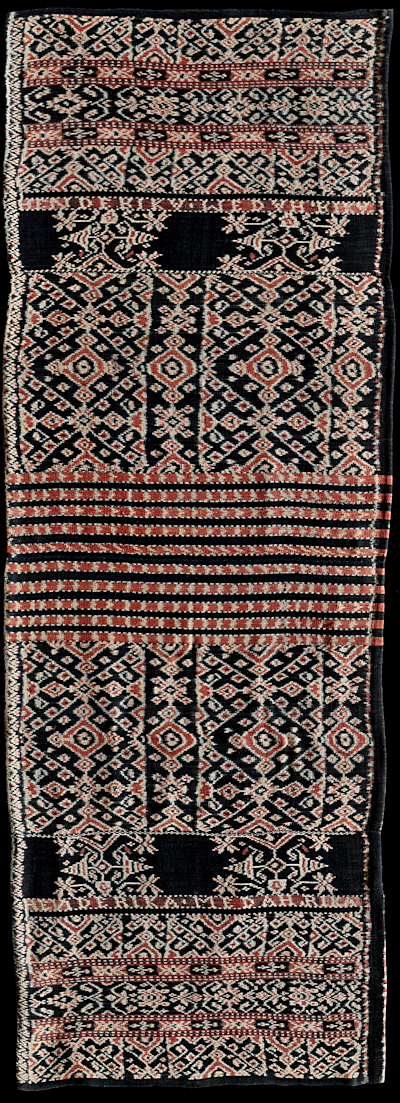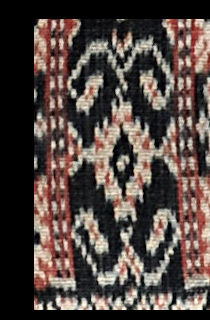| |
 
 | | | |
180 Roti Group, Roti
Pou (sarong)  
| | | Period: | Early 20th c. | | Yarn: | Cotton, hand-spun, fine | | Technique: | Warp ikat | | Panels: | 4 | | Size: | 62 x 180.5 cm (2' 0" x 5' 11") LW: 2.91 | | Weight: | 580 g (20.5 oz), 259 g/m2 (0.85 oz/ft2) | | Design: | Pou dula bunga. Top and bottom decorated with patola-inspired motifs in white and brick-red on dark, nearly black indigo ground. Mid section with black and brick red bands. The weaver has woven her name, Henderika Medah Rika, into one of the narrower bands. The spelling of the Christian name is a variation on the old Dutch name Hendrika. Medah is a Rotinese family name. Rika is the short version of Hendrika. The use of the Latin alphabet is talismanic, believed to protective by association with Christianity. Note the motifs in the second bands from top and bottom, which are very similar to the lelesepun on Toraja shrouds.  They are generally taken to represent human figures with their limbs turned inwards, and to stand for the relationship with the ancestors. This motif was not noticed on Rotinese cloth before. They are generally taken to represent human figures with their limbs turned inwards, and to stand for the relationship with the ancestors. This motif was not noticed on Rotinese cloth before. | | Comment: | Weavers on Roti, on Savu, in the Lio region of Flores and in parts of Timor (perhaps elsewhere as well) would sometimes weave their names into their cloths, to show off their literacy. The sarong has been constructed of four panels rather than the usual three: the central section with the brick red stripes is not of a piece but divided in the middle, one half forming part of the second panel from the top, the other half part of the second panel from the bottom. Very fine double ply hand spun thread, two threads in parallel. | | Background: | Chapters on Roti Group and Roti. | | Exhibited: | Hong Kong University Museum and Art Gallery, 2017. | | Published: | Ikat Textiles of the Indonesian Archipelago, 2018.
| | Compare: | 014 127 | | Sources: | Similar to pou in Khan Majlis, Woven Messages, Fig. 242, except that this piece, rather unusually, consists of four panels rather than three. On talismanic use of Latin script see Maxwell, Textiles of Southeast Asia, p. 365. Elsje Mansula identified Medah as a Rotinese family name. | | |

©Peter ten Hoopen, 2025
All rights reserved.
|
|


